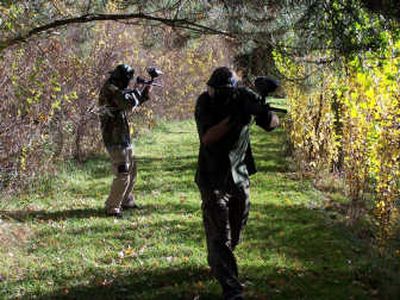Art in motion

About an hour and a half south of Spokane, in the little town of St. John, rests a beckoning oasis on 20 acres of lush greenery, scattered wetlands, wooded groves and a glassy pond. But the silence is eerie, for these here are hunting grounds.
The site is that of the Oasis Paintball Plantation, the endeavor of 24-year-old St. John native James Schierman and a few helping hands. The difference between this paintball field and other fields is that it is completely landscaped and strategically designed with sustainable products.
The young proprietor and self-proclaimed “nature freak” decided to build the paintball field on a whim, he said, to get the local kids involved and provide a “green” field for them on which to play.
“I’ve been into sustainability since I was 16, and since 16 I’ve been into paintballing. Two years ago all that came together,” he said. “I like to see what can be produced from nature. I wanted a golf course for paintballers.”
So he grabbed a bull dozer and a wheel tracker and set to work landscaping. Once complete, Schierman said there will be bunkers molded from mud and sandbag walls with straw bails and paper crates to create the structures for the games and bamboo shoots and tall wheat grass for hiding. “It will be a three-dimensional, artistically designed field that continues to change all the time with realistic-shaped buildings made out of earthen material,” he said.
And the paintballs? They’re biodegradable, too. Most of the paints are made out of mineral oils, food coloring, calcium, ethylene glycol and iodine. The shell is made of gelatin. Landscaped as a field for military combat simulation, Schierman hopes to host tournaments at Oasis as part of new kind of simulation circuit. Five-man teams would compete in military, political, squadron and civilian-simulation scenario tournaments, gaining running points and standings throughout the year at the different fields involved in the circuit. Oasis will provide the props, such as medical kits, antique flame throwers, paint grenades, locked chests and faux surveillance cameras. “I have a lot of props on the farm that go with the scenarios. I want to take my bus with all the props to other fields,” he said.
KC Crawford, co-owner of Virtual Assault Paintball Games in Spokane said he’d consider working with other fields on a circuit. “I’m interested in trying something new,” he said. “I’ve thought about doing a series where teams could accumulate points throughout the year at the different tournaments.”
Virtual Assault Paintball Games, which has been around for 16 years, has an indoor warehouse with multiple rooms for searching out opponents. Outside is a speed ball course with inflatable bunkers. “Speedball is all about skill and moving strategy,” Crawford said. Speedball, as opposed to scenario games, uses more of a sniper-type strategy, Crawford said. Often there is a flag in the center of the field and team members race to retrieve it while the opposition shoots their moving targets.
“Two things are gaining popularity right now,” said Crawford. “One is large outdoor scenarios, some up to 600 people and some that span over two days.” These include scenarios like military simulation, “U.S. vs. Canada” and “Man vs. Monster.” “The other is what you see on ESPN,” Crawford said. That is speed ball, wherein players wear brightly colored clothing and the speed and skill level is much more intense. “Players are sliding into the bunkers, using their bodies like football players,” Crawford said. “Kids want to try what they see on TV.”
What marks this sport and keeps the industry growing, Crawford said, is the adrenaline rush “ballers” get on the battle field.
“It’s such a kick. You get that high energy rush,” he said. The paintballs shoot out of the marker, the gun, at speeds up to 200 feet per second. “We set ours at 180 feet per second, but that’s still pretty fast,” said Schierman.
The popularity of the sport is growing in the Inland Northwest, Crawford confirmed, noting that more people are willing to try the sport for the first time and buy decent equipment.
“And more and more, you’re seeing father and son teams in the tournaments. It’s just a great family thing,” Crawford said.
But out there in the woods, behind that earth mound and beyond the marsh lies a land of painted uncertainty. “There’s just such an adrenaline rush of hunting and being hunted,” said Schierman.